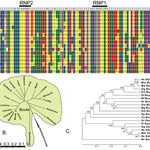Genetics & Molecular Biology

The human genome is the home of over 3 billion nucleotide base pairs packaged into 23 chromosome pairs. But despite the tremendous size of the human genome, only 1-2% of genome actually encodes for proteins.
What about the remaining 98% of the genome? At the time of Watson and Crick in the 1970s, scientists have regarded the non-coding parts of the genome as junk DNA that are remnants of evolution; including gene “fossils” that have lost their ability to be translated into functional proteins, as well as chunks of DNA that are derived from retrotransposition and duplications that occur over…

Researchers at the Buck Institute for Age Research writing in the journal Stem Cells say they have successfully used human induced pluripotent stem cells (iPSCs) to treat rodents afflicted with Parkinson's Disease (PD).
They say the research validates a scalable protocol that the same group had previously developed and can be used to manufacture the type of neurons needed to treat the disease and paves the way for the use of iPSC's in various biomedical applications.
iPSC research has come strongly into play during the last few years because of limitations on human embryonic stem cell…

Researchers at the RIKEN Center for Developmental Biology say they have unraveled the mystery of why human embryonic stem (ES) cells and induced pluripotent stem (iPS) cells undergo apoptosis (programmed cell death) when cultured in isolation, a discovery that promises new hope to sufferers of debilitating degenerative diseases.
Cell dissociation, a technique for isolating cells in procedures such as sub-cloning, poses one of the greatest obstacles to effective human embryonic stem cell research due to its damaging effects on human ES cells. 99% of human ES cells cultured in this way are…

Thimios Mitsiadis, Professor for Oral Biology at the University of Zurich, says he has shown that during tooth formation (odontogenesis) if the Jagged2 gene is inactivated, and thus the Notch signaling pathway is interrupted, tooth crowns will be malformed and enamel will be lacking.
Signaling pathways cells react to signals from their environment and one of the most important signaling pathways is the Notch signaling pathway. It is evolutionary conserved to a very high degree and it is involved in the development of all organs and tissues in animal and human embryos.
The Notch…

In a new Cell study, researchers say they have uncovered a new role for an essential cell protein polynucleotide phosphorylase (PNPASE) in shuttling RNA into the mitochondria, the energy-producing 'power plant' of the cell.
The import of nucleus-encoded small RNAs into mitochondria is essential for the replication, transcription and translation of the mitochondrial genome, but the mechanisms that deliver RNA into mitochondria remain poorly understood.
In the current study, reducing the expression of PNPASE decreased RNA import, which impaired the processing of mitochondrial genome-encoded…

John Mattick, University of Queensland, is one of the leading proponents of the idea that much -- perhaps most -- of the human genome is functional. He has been making claims along these lines for at least 15 years, but seems to always present it as a new idea. Readers of this blog may also remember the Dog's Ass Plot included in one of his publications.
Anyway, he has done an interview with BioMed Central about his thoughts on non-coding DNA, regulatory RNA, etc.
A transcript is available here in PDF. Note this statement in particular:
You mentioned earlier the possible significance of…

Genes specific to sex change rapidly but there is one sex-specific gene so vital its function has remained unaltered throughout evolution and is found in almost all animals, according to new research from Northwestern University Feinberg School of Medicine.
The gene, called Boule, is responsible for sperm production and they say that Boule appears to be the only gene known to be exclusively required for sperm production from an insect to a mammal.
"This is the first clear evidence that suggests our ability to produce sperm is very ancient, probably originating at the dawn of animal…

Can somatic cells be reprogrammed to become pluripotent stem cells? Well, the answer is yes or no, depending on your perspective, and perhaps your definition of what pluripotent stem cells should be.
A classical example of the pluripotent stem cell is embryonic stem (ES) cells found in the inner cell mass of the developing embryo. These cells are capable of multi-lineage differentiation to produce any cell type in the body, and are thus considered not only as an ideal medical tool for tissue regeneration and organ replacement, but also a great research tool to understand molecular basis of…

The cell membrane at first may seem a simple device, but it is in fact a very complex machine. The basic building block is the phospholipid, a set of molecules that have hydrophilic (water loving) heads on one side and a hydrophobic (water hating) tail on the other. Because of this relationship the water loving heads want to be near aqueous environments and the water hating tails like to be near other water hating tails, or fats. Since cells live in aqueous environments, and are filled with aqueous fluids the cell membrane forms two layers with the heads pointing out and the tails pointing…

Proteins are the workhorses of our existence. These "helmsmen of the cell" are composed of amino acids, whose sequence is already defined by the heritable information in every living being and transport substances, convey messages and carry out vital processes in their role as molecular machines.
The translation of this information during the production of proteins (protein synthesis) is determined by the genetic code and 20 amino acids form the standard set of which proteins are built.
In natural conditions, several hundred amino acids can be found and new amino acids can…